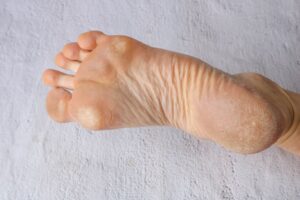Your palms and the soles of your feet feature the thickest layer of skin on your body. These areas interact with the rest of the world the most frequently through touching and walking, so they require the most protection through this skin.
But you might have noticed that the skin on the bottom of the feet or toes has grown rough and hard. The area might feel tender and look discolored. This is a callus.
These formations are usually harmless, but you might feel unhappy about how they appear on your skin. You can learn more about what they mean about your foot health when you consult a podiatrist. Or you can read on to find responses from your podiatrist to frequently asked questions regarding foot calluses.

What Causes Calluses on the Feet?
Calluses form when the skin experiences constant friction or pressure. The resulting irritation will change the skin, making it thicker and tougher. Though pain and redness when the callus originally forms might fade, the rough texture can remain until you seek treatment.
People who wear ill-fitting or uncomfortable shoes can have a higher risk of forming calluses on their feet because the shoes will rub against the feet and toes. Athletes, including those who do long-distance running or weightlifting, can also have an increased chance of calluses due to repetitive, high-pressure actions.
A callus appears as a rough patch of skin. But if you notice a round spot of swollen skin with a hard center, you might have a corn. A corn forms similarly to a callus, but the skin damage penetrates deeper, which can be more painful.
Are Calluses Harmful?
Calluses and corns on their own are not overly harmful. But some people feel uncomfortable with the tenderness and appearance of them on their feet. Occasionally, calluses pose a risk of infection if the damaged skin cracks.
For patients with diabetes, these small injuries on the foot and infections can have a greater danger. Those with diabetes can experience nerve damage which means you might not feel when calluses worsen. They could have a higher chance of forming dangerous ulcers.
If you have questions or carry risk factors like diabetes, talk to your podiatrist. They can help you manage or get rid of calluses and corns to protect your foot health.
How Can I Get Rid of Foot Calluses?
If you want to get rid of a corn or callus, especially if you suspect complications with this condition, call your podiatrist. They can perform a short treatment to remove the problematic skin without hurting other parts of your feet. Do not attempt to trim or cut away a callus on your own because you could have a high risk of infecting the area.
Take care of your feet routinely in order to prevent calluses and protect the skin on your feet. If you think you might form a callus, soak your feet in warm water to soften the skin.
You can exfoliate the skin on your feet with a pumice stone gently to remove dead skin. Moisturize your skin daily to keep the area healthy.
